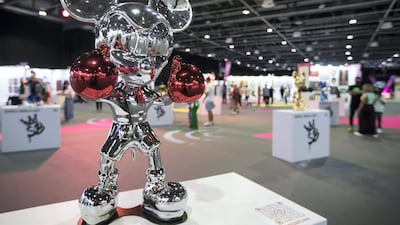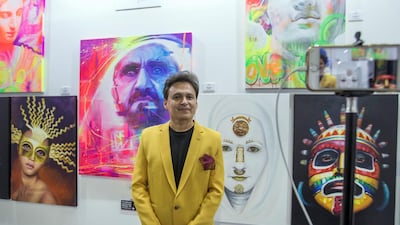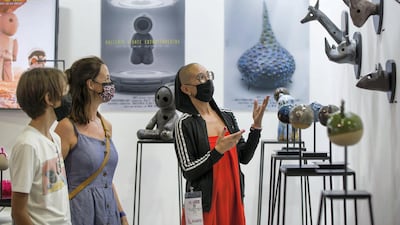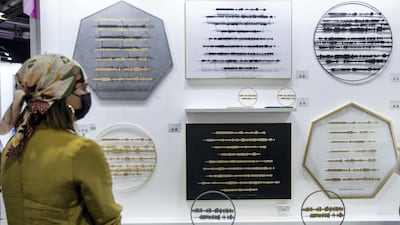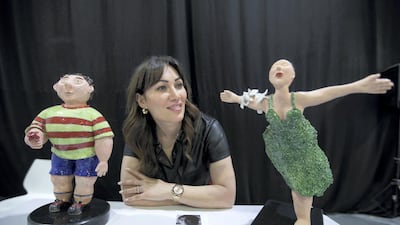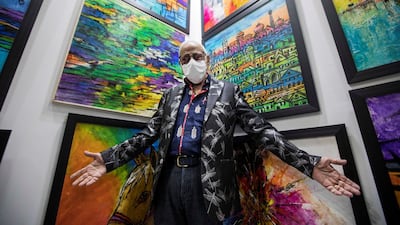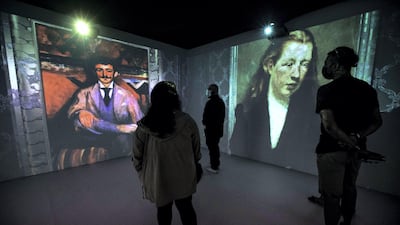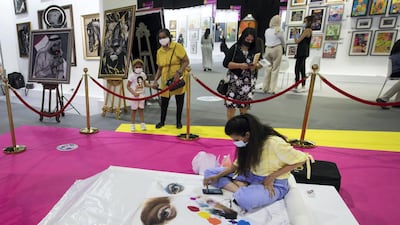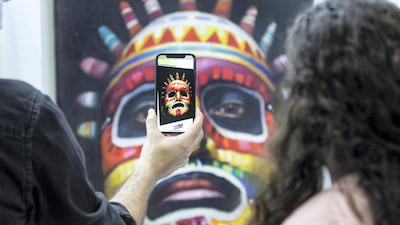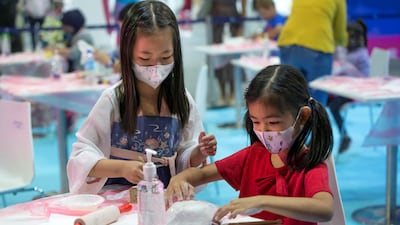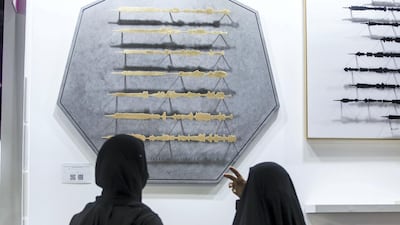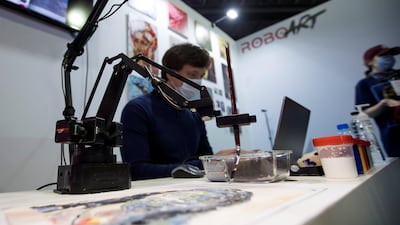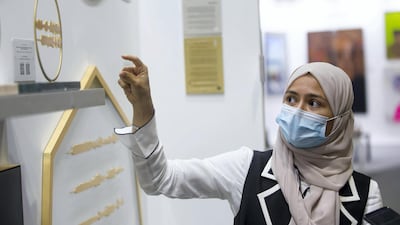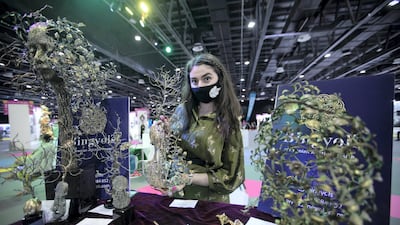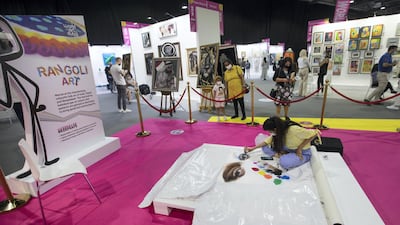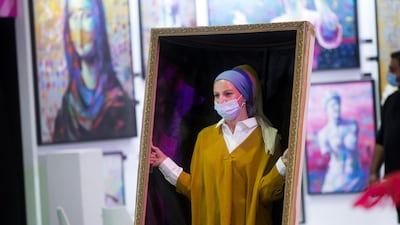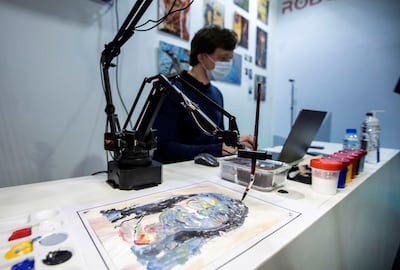Abstract artworks from India painted with kitchen spices, portraits of Ecuadorian mythical figures best seen through augmented reality and impressionist paintings made by a robotic arm from Russia are only some of the highlights at this year's World Art Dubai.
The sprawling fair, taking place at Dubai's World Trade Centre until Saturday, brings together 250 galleries and artists from around the globe, many of whom you're likely to have never heard of – and that’s exactly the point.
Coming fresh off the heels of Art Dubai, the fair is less interested in showcasing the works of established artists than it is with giving emerging names a chance to share their art. All the works are for sale, ranging from a few hundred dirhams to tens of thousands, and you'll find plenty of magnetic and surprising pieces to make it worth a visit.
Like any recent event, health measures have been put in place to thwart the spread of the coronavirus, so make sure to book your ticket online ahead of your visit. Most paintings and sculptures have handy QR codes beside them, so you don't need to pick up pamphlets either.
Before you even set foot in the exhibition hall, you'll come across XLIX, a collection of 49 colourful dolls, identical in shape and size, with large bulbous heads and aplomb postures. Created by Belgian artist Griet Van Den Auwelant, the dolls are made of concrete, each weighing 7 kilograms and standing at 37 centimetres tall, but that is where their similarity ends. Once she had finished casting them, Van Den Auwelant, who lives in Dubai, distributed the dolls to 30 female artists, each of whom painted and decorated the work as they saw fit.
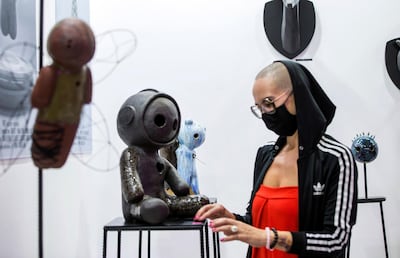
The dolls, Van Den Auwelant says, are meant to reflect people. "They are the same on the inside but different on the outside," she tells The National. "Just like us."
Van Den Auwelant is also exhibiting more of her work at the fair. Her art includes angular iterations of animal trophies and large spherical heads planted on upright iron stands. "They each have a name and a story, an essence" she says of the heads – her most recent work. "There's Lala, who brings deep love, and Dune who has a warrior's energy. Some are majestic and dreamy, and others, like Spike, have a 'cool dude' attitude."
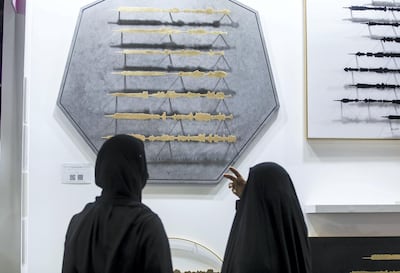
Syrian architect and urban designer Sara Alharbali, who is the founder of the luxury brand Tajrid Design, is exhibiting her Revelation Spectrogram series, which brings to visual form the recitations of different Quranic verses by Abdul Basit Abdul Samad, considered to be one of the best reciters of the Quran who ever lived.
The works display the sound waves of Abdul Samad's recitations in a steel finish with gold leafing or a black powder coat. From a distance, the artworks verge on abstract, and it's only on closer inspection that the lilting horizontal lines become clear sound waves, with an inscription at the bottom of each artwork detailing which verse is being displayed.
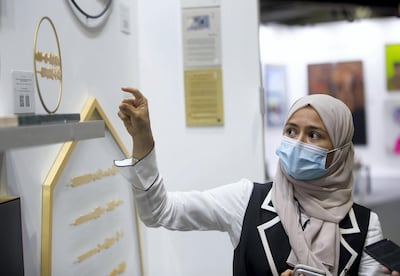
"Usually as Muslims, we have Arabic calligraphy or Kufic scripts of Quranic verses in our homes," she says. "We look at them and they look nice but we don't usually reflect upon them. The idea behind Revelation Spectrogram is that you see the sound wave and wonder what it means and then, as you discover the name of the surah, it'll inspire you to dig deeper into what it means and what Allah is trying to tell us."
One of the oldest participants at World Art Dubai is Anjini Laitu, 80, an Indian who has been living in Dubai since 1991. Wearing an eye-catching black blazer scuffed with brilliant silver scrawls, Laitu sits at his stall surrounded by dozens of colourful, richly textured paintings.
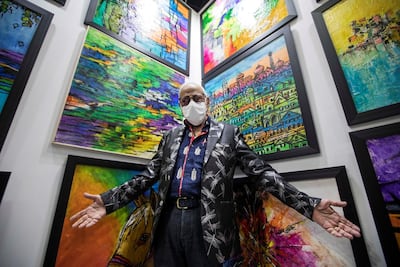
"This was made entirely of materials you can find in your kitchen," he says, pointing to one of his pieces. "There's turmeric, red chili powder, cumin powder and beetroot juice. I made the painting last month. There were no [traditional] painting materials used for this," he says. Pointing to another of his works, he explains: "This was made only by using Holi [Indian spring festival] powder colours."
Laitu says he has been participating at World Art Dubai every year since its inception in 2015. “It’s bigger than ever this year,” he says of the seventh iteration. “I’ve exhibited artworks in the UAE, India, Sri Lanka and Nepal, and I make sure I participate here every year. My experience has been very good, which is why I keep coming back.”
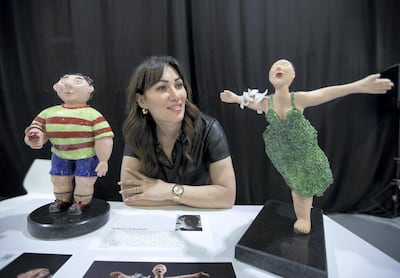
Across the hall, Iraqi-Armenian artist Ankina Zakarian, a sculptor who is fairly new to the craft, is exhibiting the work she created during the pandemic. The sculptures all show human forms with exaggerated features, such as beefy limbs and sprawling broad shoulders. Zakarian says she hopes the sculptures transmit a level of optimism.
"One of my favourite works is this one," she says of a male figure in a striped lime and red t-shirt. "I worked on him when the stay-at-home measures were imposed and we couldn't go out. He gave me a sort of happiness."
Zakarian says one of her main motives to take part in World Art Dubai was the chance to be in conversation with other artists, receive feedback and artistically grow.
“I’ve been getting the chance to meet several new people,” she says. “And I’m feeling inspired by their philosophies and artistic intentions. I think an artist always needs to take that step, to learn more and develop.”
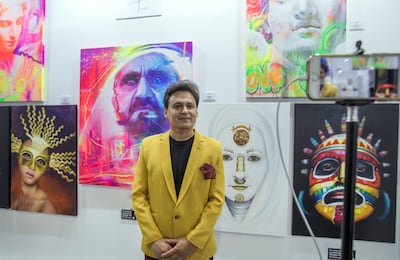
Then there are the works that are best experienced virtually. Ecuadorian artist Coco Valdez's paintings may seem impressive enough at first glance, featuring motifs and mythological symbols stemming from Ecuador's long and rich history. But after downloading an app he developed himself, the paintings come alive in vibrant and unexpected ways.
At the centre of his stall is a portrait of Sheikh Mohammed bin Rashid, Ruler of Dubai, entitled Forward Dubai. Valdez says he painted the portrait of the Ruler, who is also the Vice President and Prime Minister of the UAE, as a tribute to the country's innovative nature.
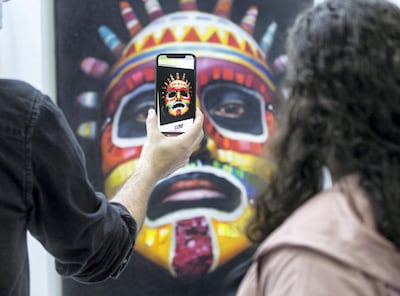
“I painted it especially for this exhibition. I asked myself: 'What is Dubai for me?'. The city is the future, it is technology,” he says.
Another impressive attraction at the fair is the AI Norn, a robotic arm created by Russian data scientists Anna Mischenko and Nikolay Gavrilin. With the help of a programme, the arm is able to take an image and interprets it as an impressionist painting.
“The programme breaks down the image according to lines, shapes and colours,” Mischenko explains. “The arm then mixes the paints on its own and applies it to the canvas.”
The duo have called this unique painting approach "neuro-impressionism" . "We are both big fans of impressionism but as we can't paint ourselves, so we decided to come up with a programme that does it for us."
